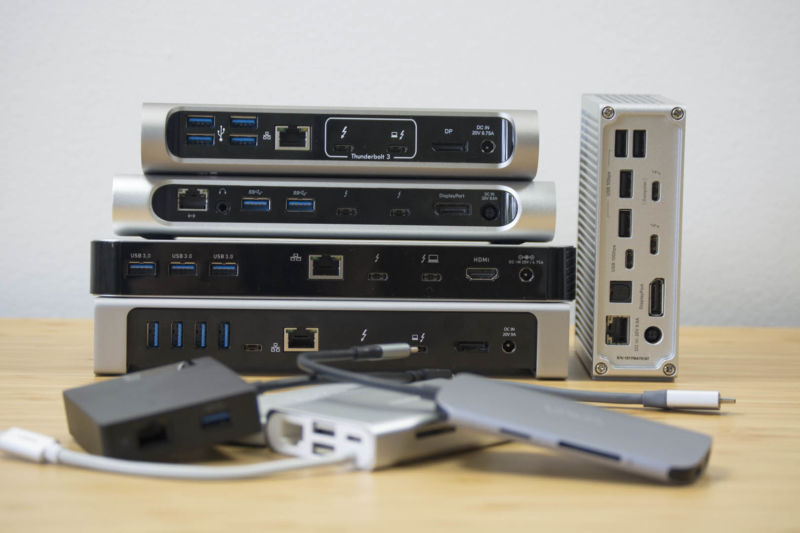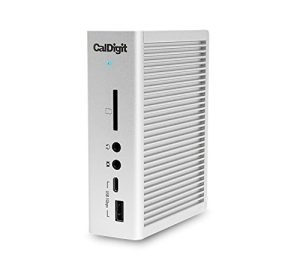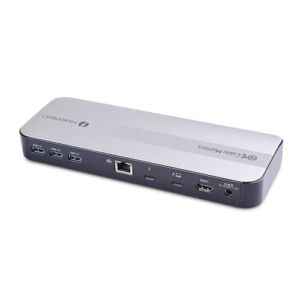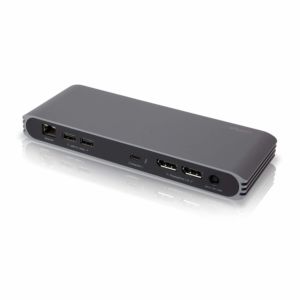

reader comments
313 with 180 posters participating
The introduction of USB-C and Thunderbolt 3 ports and the transition away from legacy ports hasn’t been smooth. PC and smartphone OEMs began using the USB-C port a few years ago because it allowed companies to make thinner devices with faster ports. Gargantuan in comparison, the USB-A ports we all know and love from thumb drives take up a lot of space on devices, they don’t handle data transfer as efficiently as new ports, and they’re limited when it comes to multiple connections and charging.
USB-C and Thunderbolt 3 are the way of the future, but most of our accessories are stuck in the past. PC and smartphone OEMs led the way by adopting USB-C as standard, but that often leaves users to search for an adapter or dongle to connect all of the peripherals they already have. On top of that, many new peripherals are still using the old connections.
Rising to the occasion are USB-C and Thunderbolt 3 docks—boxy devices punctured by USB-As, HDMIs, DisplayPorts, and SD card readers—and other ports. A dock or hub connects to all your peripherals so you can then connect it to your PC through just one USB-C port. But not all docks are created equal. After reviewing a wide array of what’s available today, here are a few of the key features to look for when choosing the best option to bridge the gap between your PC and everything you want to use with it.
Note: Ars Technica may earn compensation for sales from links on this post through affiliate programs.
The short version
- Ever since first publishing this guide over one year ago, CalDigit’s TS3 Plus has remained in the top spot as our favorite Thunderbolt 3 dock. You get what you pay for in this $309 dock: it has some of the fastest data transfer speeds out of all the docks we tested, so transferring data between a portable SSD and your PC will be just as fast using the TS3 Plus as if you were connecting the SSD to your PC directly. We also love its compact, industrial design that holds all the ports you’d ever need and its ability to drive up to two 4K external displays at 60Hz.
- As a runner-up, Cable Matter’s Thunderbolt 3 dock offers almost the same advantages as CalDigit’s does but it has a less elegant design. However, it is more affordable at $239.
- Even more affordable still is our budget pick, the new $199 CalDigit Pro Dock. In addition to its attractive price tag, the CalDigit Pro Dock works with both Thunderbolt 3 and USB-C PCs, so it’s a good option if you don’t know exactly which type of USB-C port your device has or if you’re getting it as a gift and don’t know the capabilities of your recipient’s PC.
- Cable Matters produced our favorite non-Thunderbolt 3 USB-C dock in its USB-C Dual 4K DisplayPort dock. Like CalDigit’s Thunderbolt 3 accessory, Cable Matter’s USB-C dock combines an elegant design with fast transfer speeds and a ton of port options at a good price of $169. It also has dynamic bandwidth switching, allowing you to control the speed of data transfers versus the quality of your connected external displays.
- Meanwhile, Kensington’s $99 SD2000P nano dock is our budget pick on the USB-C side because it provides some of the best technical features found in our top pick in a smaller device that comes in at a more affordable price. We also like that it can be VESA mounted with the purchase of an additional accessory.
- For those who want a travel-friendly hub, OWC’s Travel Dock is the best option at $55. It’s pretty speedy when it comes to data transfer, especially considering most travel hubs and adapters sacrifice speed while trying to be as portable as possible. It connects to your laptop through an attached USB-C cable that hides neatly under the device when not in use, and it supports power-delivery passthrough so you can charge your laptop through it.
- Those looking for an even more compact device that also has an Ethernet port should consider VAVA’s $60 USB-C adapter.
Thunderbolt 3 docks
Best overall
CalDigit TS3 Plus Thunderbolt 3 Docking Station
-
CalDigit’s TS3 Plus docking station.Valentina Palladino
-
The front edge has an SD card slot, individual audio in and out ports, one USB-C port, and one USB-A port.Valentina Palladino
-
It can be positioned horizontally or vertically on your desk or work area/Valentina Palladino
-
The back side has the rest of the ports, which includes a DisplayPort, four more USB-A ports, and two Thunderbolt 3 ports.Valentina Palladino
| Specs at a glance: CalDigit TS3 Plus Thunderbolt 3 Station | |
|---|---|
| Price | $299 |
| Ports | 2 x Thunderbolt 3 1 x USB-C 3.1 Gen 1 1 x USB-C 3.1 Gen 2 5 x USB-A 3.1 1 x DisplayPort 1.2 1 x SD card reader 1 x digital optical audio (S/PDIF) 1 x Gigabit ethernet 1 x analog audio in 1 x analog audio out |
| Power delivery | 85W |
| Display options | Two displays (up to 4K @ 60Hz) or one display (up to 5K @ 60Hz) |
| Dimensions | 5.15×1.57×3.87 inches |
| Compatibility | macOS 10.12 and up, Windows 8/10 |
CalDigit’s unassuming, industrial-looking TS3 Plus Thunderbolt 3 docking station provides the best combination of performance, port selection, and design versatility out of all the Thunderbolt 3 docks we tested. It not only has the smallest footprint of them all—it also has the most ports.
Most users will have no trouble connecting mice, keyboards, and other legacy peripherals using its five USB-A 3.1 ports, and its four USB-C ports offer an array of connectivity options. Two of them are Thunderbolt 3 ports (one of which is the PC connector port), while the other two are USB-C 3.1 Gen 1 and USB-C 3.1 Gen 2, giving you various transfer speed options to choose from.
As evidenced in our benchmark charts, CalDigit’s TS3 Plus didn’t always produce the fastest transfer speeds or read/write speeds, but it was consistently one of the top performers. The differences in results among our top three choices were usually minimal, as all of them produced read/write speeds close to the default read/write speeds produced when the Samsung T5 SSD was connected directly to the MacBook Pro or XPS 13 two-in-one via a Thunderbolt 3 port.
The TS3 Plus charged the MacBook Pro and the XPS 13 fairly quickly—the MacBook Pro went from 50% to 100% charged in just over one hour. The device took the longest amount of time to charge the iPhone 6S Plus through one of its charging-capable USB-A ports. But even then it took just two minutes longer than Plugable’s Thunderbolt 3 dock and 13 minutes longer than Cable Matters’ device. Also, all of the TS3 Plus’ USB-A ports support 7.5W charging, allowing you to power up more than one accessory at a time. Most other docks we tested had just one charging-capable USB-A port.
Using this hub’s DisplayPort and Thunderbolt 3 port, users can connect up to two 4K 60Hz displays or one 5K 60Hz display. You will need an adapter to achieve the highest-possible refresh rate and screen fidelity as you connect more than one display at a time. But the option is there for you.
The TS3 Plus’ design set it apart from the competition. The relatively small silver metal box measures 5.15×1.57×3.87 inches and spreads its ports out thoughtfully across the two longest sides. The back contains the PC connector Thunderbolt 3 port plus an additional Thunderbolt 3 port, four USB-A 3.1 ports, one USB-C 3.1 Gen 2 port, one DisplayPort, one Gigabit Ethernet port, one S/PDIF digital optical audio port, and the DC power port. The front houses an SD card slot, analog audio in and audio out ports, one USB-C 3.1 Gen 1 port, and one USB-A 3.1 port.
I especially appreciated the variety of front-facing ports because they make connecting temporary peripherals and accessories easier. Depending on your setup, access to the back of the dock might be blocked or covered by a web of cables—finding a port like a headphone jack among a sea of other connectors on the back of a dock would be quite frustrating in that situation.
A light gray, rubber-like pad covers the bottom side of the TS3 Plus, allowing you to position the dock horizontally or vertically without scuffing up your desk. Most other docks take up a lot of space as they lIE horizontally on your desk, so the added flexibility of the TS3 Plus’ design is a convenient perk. The dock is made better by CalDigit’s Docking Station Utility program (available as a free download from its support website) because it lets you disconnect individual accessories connected to the dock. You can clearly and safely choose to disconnect your eGPU and external drive without disconnecting any other accessories like displays and mice, for example, or choose the option to disconnect all devices at once.
CalDigit’s TS3 Plus is the dock I’d want on my desk going forward, not only because of its design, but also because of its performance and well-rounded port selection. It may be slightly more expensive than our other top picks, but its perks justify the $299 price tag.
Good
- Compact design yet contains a plethora of ports.
- Supports digital optical audio output.
- Includes extra USB-C 3.1 Gen 1 and Gen 2 ports.
Bad
- Adaptor required to achieve highest possible refresh rate when connecting more than one display.

CalDigit TS3 Plus
Runner up
Cable Matters Thunderbolt 3 dock
-
Cable Matters’ Thunderbolt 3 port is a basic silver slab, but it has great performance.Valentina Palladino
-
The narrower front edge holds power and PC indicator lights, along with an SD card, two USB-A ports, and headphone/mic jack.Valentina Palladino
-
The wider back edge has more ports, including an HDMI port, three more USB-A ports, and two Thunderbolt 3 ports.Valentina Palladino
-
All ports are evenly spread throughout the back edge, which should make it easy to connect peripherals to all of them.Valentina Palladino
-
Unlike CalDigit’s Thunderbolt 3 dock, not all of Cable Matters’ USB-A ports support charging.Valentina Palladino
| Specs at a glance: Cable Matters Thunderbolt 3 dock | |
|---|---|
| Price | $239 |
| Ports | 2 x Thunderbolt 3 5 x USB-A 3.0 1 x HDMI 1 x Gigabit ethernet 1 x SD card reader 1 x headset/mic combo out |
| Power delivery | 60W |
| Display options | Two displays (up to 4K @ 60Hz) |
| Dimensions | 9.1×3.4×1.1 inches |
| Compatibility | macOS 10.12 and up, Windows 10 |
Cable Matters’ Thunderbolt 3 dock makes compromises in versatility but, thankfully, not in performance. Compared to CalDigit’s TS3 Plus, this dock has the same number of USB-A ports, but it lacks additional USB-C ports, it doesn’t support S/PDIF output, and it only has 60W charging power for your host laptop. Also, only one of its USB-A ports supports charging, so you can only charge one phone, tablet, or other device at a time.
However, its performance is quite good. The Cable Matters Thunderbolt 3 dock beat CalDigit’s dock on most of our benchmark tests, albeit by a slim margin. Our top three choices all produced fast transfer and read/write speeds, so all of them will work quickly and efficiently when transferring data. But if speed is the most important factor for you when choosing a Thunderbolt 3 dock, Cable Matters’ device is the one to get.
The device has an HDMI port for video output rather than a DisplayPort, so keep that in mind when buying the appropriate cables and adapters for your monitors. It’s also possible to connect a second 4K display through the second Thunderbolt 3 port (the one that isn’t designed to connect to the host PC), but you will need an active USB-C cable to do so.
The Cable Matters Thunderbolt 3 dock won’t look as sleek on your desk as CalDigit’s device because it’s just a long, metal-and-plastic slab that can only sit horizontally on your desk. I appreciated the ports accessible on the front of the device (two USB-A ports, the SD card reader, and a headphone/mic jack), but the rest sit along the back edge of the device. While there’s nothing wrong with the design, it’s boring in comparison to CalDigit’s and Plugable’s devices (the former of which we’ll get to in the next section). However, that’s one of the compromises you’ll make for the $219 device. Overall, it’s a solid dock with great performance at a decent price.
Good
- Consistently fast read/write speed and data transfer performance.
- More affordable than CalDigit’s TS3 Plus.
Bad
- Boring, bulky design.
- Doesn’t support S/PDIF output.

Cable Matters Thunderbolt 3 Dock
Best Budget
CalDigit Pro Dock
-
CalDigit’s Pro Dock has a metal design that looks like a lot of other Thunderbolt 3 docks.Valentina Palladino
-
It will work with Thunderbolt 3 PCs and computers with lesser USB-C ports.Valentina Palladino
-
The front edge has a couple quick-access ports including one USB-C and one USB-A port.Valentina Palladino
-
The back edge has the rest of the ports, which includes two DisplayPorts and an Ethernet port.Valentina Palladino
| Specs at a glance: CalDigit Pro Dock | |
|---|---|
| Price | $199 |
| Ports | 1 x Thunderbolt 3 1 x USB-C 3.2 Gen 2 3 x USB-A 3.3 Gen 1 2 x DisplayPort 2.1 1 x SD card reader 1 x Gigabit ethernet 1 x 3.5mm audio jack |
| Power delivery | 85W |
| Display options | Thunderbolt 3 PC: two displays (4K @ 60Hz)/USB-C PC: two displays (720p) or one display (4K @ 30Hz) |
| Dimensions | 8.43×3.15×0.98 inches (214×80×25 mm) |
| Compatibility | macOS, Windows 10 |
CalDigit’s new Pro Dock is not only a well-priced Thunderbolt 3 accessory at $199, but it will work seamlessly when connected to either a Thunderbolt 3 and USB-C PC. As we explain above, there are a number of differences between Thunderbolt 3 and USB-C, and some features are only available on devices with Thunderbolt 3 ports. CalDigit’s Pro Dock will adapt to work precisely regardless of which level of USB-C port you connect it to, making it a good option for those who are unclear which connector their PC has (or if those getting it as a gift and don’t know the specs of their recipient’s PC).
When connected to a Thunderbolt 3 PC, the Pro Dock supports data transfer speeds up to 40Gbps, dual display output for 4K monitors at up to 60Hz via its two DisplayPorts, and a maximum 85W of laptop charging. When connected to a USB-C Gen 2 device, it’ll support data transfers speeds up to 10Gbps, dual 4K at 30Hz monitor output, as well as 85W laptop charging. Those with USB-C Gen 1 devices will see maximum data transfer speeds of 5Gbps, dual HD monitor output, and a maximum 85W laptop charging.
The Pro Dock is also compatible with the newest iPad Pros, allowing users to connect the tablet to an external display as well as connect peripherals and accessories like external hard drives.
We were impressed with the Pro Dock’s data transfer speeds, and since we test these docks with a MacBook Pro and an XPS 13, you’ll notice the speeds are quite high because the Thunderbolt 3 ports on those laptops support faster data transfer speeds.
While the device has a good array of ports, it only has one extra Thunderbolt 3 port that it only supports data transfers. You won’t be able to daisy-chain a monitor through this port, but CalDigit added two display ports on the back edge of the device to make up for that. But the Pro Dock can be daisy-chained in a sequence if it’s added to the very end of a Thunderbolt 3 daisy-chain, just keep in mind that you’ll see weaker performance in the Pro Dock (as well as other devices) the further away in the chain it gets from the host PC.
Despite the daisy-chaining inconvenience, the CalDigit Pro Dock provides a lot of value for its $199 price tag. Most Thunderbolt 3 docks still sit above the $200 mark, so it’s a good option for those who have a tighter budget as well as those who want the convenience of a dock that works well with both Thunderbolt 3 and USB-C PCs.
Good
- Solid and relatively affordable dock that works with Thunderbolt 3 and USB-C PCs.
Bad
- No HDMI port.



